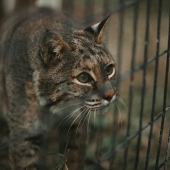BOBCAT
Class: Mammalia Order: Carnivora Family: Felidae Species: Lynx rufus Status: The Mexican bobcat is listed as endangered, but no other subspecies is currently protected by the Endangered Species Act.

Bobcats, also known as wildcats, are notable for their “bobbed” tail, which is typically four to seven inches in length. Their color is typically reddish-brown with black spots. Their faces are surrounded with a ruff like fur and their ears are tufted, which allow for greater hearing. They belong to the Lynx genus and are the smallest of the four species of Lynx.
LIFE SPAN
In the wild, bobcats will live about 12 to 13 years. In captivity though, bobcats can live up to 32 years.
DIET
Small animals such as snowshoe hare, rabbits, foxes, birds, mice, and other rodents make up the staple diet of the bobcat; however, the bobcat is capable of bringing down prey up to ten times their body weight, such as an adult deer. The Catty Shack Ranch follows the USDA guidelines and feeds according to their body weight. They also follow strict nutrition requirements from their veterinarians and also add vitamins and minerals to all their food. The bobcats in residence at Catty Shack are fed chicken, beef, and a special treat, raw eggs!
SIZE
Bobcats can grow up to 41 inches from head to tail base. Males weigh an average of 26 pounds, while females average 20 pounds.
HABITAT & NUMBERS
Bobcats live throughout the U.S. and in parts of Mexico and southern Canada. Bobcats can tolerate many different types of habitats including temperate forests, mountains, deserts, swamps, and scrubland. The typical range of a male bobcat covers 25 to 30 square miles, depending upon food resources, and the female maintains approximately five square miles of territory. Bobcats maintain several dens throughout their territory for shelter and safety. Current estimations of the bobcat population run anywhere between 725,000 to 1,020,000 wild individuals. Hunting and trapping of these animals exists throughout most of their range, and they are often killed for their beautiful fur.
REPRODUCTION
Bobcats will generally mate in late winter, but can mate all year depending upon their mating success. Courtship between the male and female lasts one to two days, after which they go their separate ways. Females will produce litters of one to six babies after a gestation period of 60 to 70 days, and the newborns weigh between 10 and 12 ounces at birth. Kittens will nurse for the first two months and then will begin exclusively eating solid food provided by their mother. They begin learning to hunt at around five months old and then, when they are between 8 and 11 months, they will leave their mother in search of their own territory. Females will generally begin reproducing at two years of age.
OTHER FUN BOBCAT FACTS
Bobcats will store their left over food for later, often covering it with leaves or grass to hide it from other animals.Bobcats are the most common wildcat found in North America.
Bobcat prints have four round pad prints on both their front and back legs; however, the paws on their forelegs actually have five toes. The fifth toe is not found in the print due to the high placement on its leg.
Bobcats have great eyesight and hearing; however, their sense of smell is not acute.
Speeds of a bobcat can reach up to 31 miles per hour!
Bobcats are found only in North America. Their cousins, the Lynx, are located elsewhere on the planet and are known as the Canada Lynx, Eurasian Lynx, and Iberian Lynx.
Bobcats can leap up to 25 feet!
When walking, bobcats will place their back feet in the print of their front feet to lessen the amount of noise they make.
Bobcats are exclusively carnivorous.

